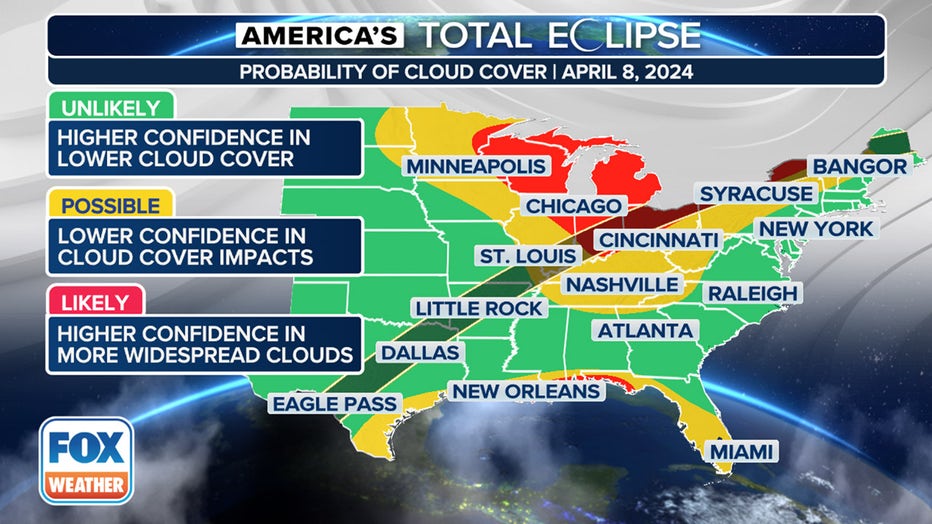Total solar eclipse forecast: Who has best chance for clear skies on April 8

Eye protection for April's total solar eclipse
If you?re among the millions of people who will get the chance to witness April?s total solar eclipse, you?re going to want to use eye protection. Vitreoretinal surgeon at New York Eye and Ear Infirmary of Mount Sinai Dr. Avnish Deobhakta joined FOX Weather on Sunday to explain the dangers of viewing the eclipse without proper eye protection.
Early forecasting for the total solar eclipse shows a higher probability of a mostly clear sky along parts of the path of totality in Texas, Arkansas and portions of northern Maine.
On April 8th, a total solar eclipse will be visible across parts of Mexico, Canada and the U.S., from Texas to Maine. A total solar eclipse happens when the Moon passes between the Sun and the Earth, completely blocking the face of the Sun for several minutes. It will be the last time a total solar eclipse passes over a large part of the U.S. until 2044.
To experience the full eclipse, you'll need a pair of solar glasses and to be located along the more than 100-mile-wide path during totality. A clear sky is also key to watching a total solar eclipse.
The FOX Forecast Center has put together the color-coded map below, showing areas more or less likely to be impacted by cloud cover during the eclipse. As the eclipse nears, computer forecast models will improve and be able to give forecasters a better idea of what the sky will look like on the big day.
PLANNING AN ECLIPSE ROAD TRIP? AAA SHARES TRAVEL ADVICE, SAFETY TIPS AHEAD OF APRIL 8TH
Two weeks ahead of the eclipse, the FOX Forecast Center has high confidence that Dallas and San Antonio in Texas, Little Rock in Arkansas and Caribou in Maine are less likely to have heavy cloud cover on April 8th.

The eclipse cloud cover forecast from FOX Weather. (Credit: FOX Weather)
"Everything in green, this is going to be your best chance to see the solar eclipse," FOX Meteorologist Adam Klotz said. "How did we get to this? Well, it's a combination of just historic climatology. These are areas where typically there's a little less cloud cover. Additionally, we're now just getting close enough that you can put some long-range forecasts into this."
Many areas in Texas are preparing for high traffic and visitors for the solar eclipse. Some counties along the path of totality have already declared states of emergency.
There is also high confidence in lower cloud cover in parts of northern Maine, according to the FOX Forecast Center.

Cloud cover averages on April 8th based on 30 years of data. (Credit: FOX Weather)
Chances of cloud cover begin increasing toward the middle of the eclipse path west and north of Nashville, Tennessee.
In Chicago, Illinois, and Cincinnati, Ohio, there is higher confidence of more widespread cloud cover during the eclipse.
WHAT HAPPENS TO CLOUDS DURING A SOLAR ECLIPSE? NEW RESEARCH MAY SURPRISE YOU
We can also look at cloud climatology data to see where clouds are more likely to cover the eclipse on April 8th. The map below shows the cloud cover averages over the past 30 years. So far, this data is lining up with the early eclipse forecast for 2024.
It's also important to note that even if it's cloudy, you will likely still see at least some of the eclipse.
HOW TO SAFELY WATCH A SOLAR ECLIPSE
A detailed forecast will be available about a week before the eclipse.
Check back with FOX Weather for updates to the forecast as the date of the eclipse approaches, and add your viewing location to the "Events" tab in the FOX Weather app.

